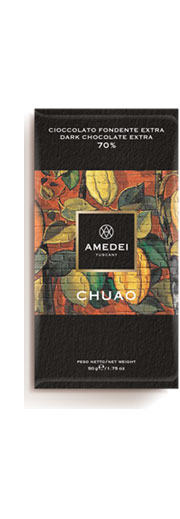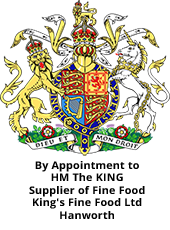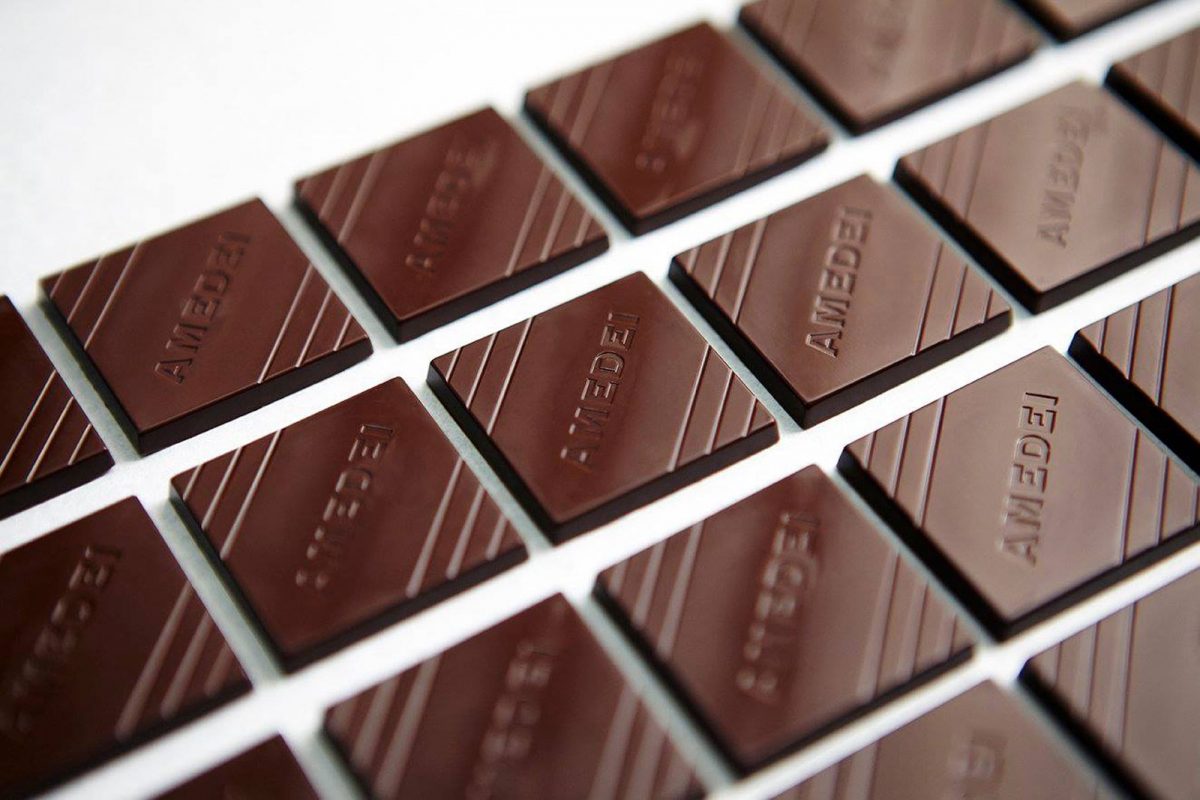King's Fine Food Blog, News
An Explanation of Chocolate by Sara Jayne Stanes
Sara Jayne Stanes …it’s the chocolate’s fault! It wants us to eat it…!
CHOCOLATE IS UNIQUE. It is the only substance that melts in the mouth at body temperature, subtly exploding into an intoxicating rainbow of flavours. This singularly hedonistic and deeply satisfying experience has earned chocolate a role in everything from seduction to the demise of slavery to a venerated staple of the herbal pharmacopoeia. Of course, we are talking really serious chocolate here …
WHAT IS FINE CHOCOLATE? Chocolate is cocoa mass or cocoa liquor – the combination of the roasted and ground kernel of the ‘cacao’ bean, the principle part of which is cocoa butter, (ie the fat released when the bean is ground), and sugar. This is then refined and processed. Chocolate may also contain lecithin, a natural emulsifier, and flavours such as natural vanilla, and in the case of milk chocolate, milk solids.
WHERE DOES THE CACAO BEAN COME FROM? Cacao comes from the seeds of the rainforest trees which grow 20◦ north and 20◦ south of the Equator. These trees are named Theobroma Cacao which means ‘Food for the Gods’. There are three major varieties of cacao beans: Criollo, Trinitario and Forastero – Criollo being the rarest of the three.
WHERE DOES THE NAME CHOCOLATE COME FROM? The name ‘chocolate’ most probably comes from the Olmec/ Mayan /Aztec word ‘xoco-atl’ (pronounced whocko -atle) meaning ‘bitter water’. This is a fatty, grainy drink made from the crushed roasted and ground cocoa beans, sometimes with the addition of herbs and spices.
WHEN WAS CHOCOLATE FIRST DISCOVERED? History points to evidence of ‘cacao’ around 6,000 years ago, but the Olmecs were the first recorded people to have found uses for chocolate, circa 1500 BC via the remains of cacao found in the graves of monks. It was thought that they were gifts for the gods on their journey from earth to the afterlife. Cacao was used in ceremonies as offerings to the gods, just as many of us use the communion bread and wine as the body and blood of Christ. The Mayans believed that in order for the sun to rise every morning, cacao has to be prepared and offered to replace the blood that the sun has lost in its overnight fight with the jaguar. Queztalcoatl (Ketzalco-atle) was the name of the God of Cacao, as it was he who introduced the cacao seeds to humans and showed them how to use it.
WHEN DID CHOCOLATE COME TO EUROPE? After the Spanish invasion of Mexico in 1520 and the slaughter of the Aztecs, Cortes brought it back to the King of Spain in 1527. However, chocolate remained a very Spanish secret but eventually, over 100 years later, it arrived in England around the middle of the 17th Century – at the same time as coffee and tea. Influenced by the whole range of medicinal remedies passed down from the New World, here in England it was also used in medicine and soon became a very important part of the apothecary’s (old fashioned pharmacists) medicine chest. With the introduction of new machinery, people discovered ways of making the fatty grainy medicinal drink taste a lot better. As more people began to enjoy the taste of it and people became more skilful at using the cocoa, in the middle of the 19th century a new chocolate product was discovered in the form of a pastille (or bar of chocolate). Today, names like Cadbury, Fry (under the Cadbury aegis), Rowntree (now Nestle) produce a large amount of the chocolate in this form for us to eat and enjoy.
USES FOR CHOCOLATE Chocolate has many uses, and in the beginning, was even used to treat illnesses! The Native Americans used to use it to cure their sicknesses and it was alleged to cure itches, prevent tumours, and encourage sleep. By the 1680s, it was thought that chocolate could restore energy after a hard day’s work, help stop lung infections, or strengthen the heart and cure hangovers!. There were a few conditions that weren’t improved by chocolate, including tuberculosis, toothaches, and ulcers.
SO, IS CHOCOLATE GOOD FOR US? We should certainly not feel guilty about eating it – as long as it is ‘real’ chocolate, of course. Research is constantly coming up with all the healthy elements in chocolate, for example: Blood pressure: Chemicals called ‘flavenols’ which are present in cocoa drinks and to a lesser extent in chocolate, can help to regulate blood pressure. Research at Harvard Medical School has shown that the benefits can be as great as those of aspirin. Deep vein thrombosis: The chances of developing this condition can also be prevented by flavonols. According to research, a 50g bar of chocolate contains the same concentration of the chemicals as 4 ½ cups of tea, six apples or seven onions. Heart disease: Flavonols are also known to improve the cardiovascular system and to help to prevent coronary heart disease. But remember, there are very real differences between what’s in fine chocolate and that of newsagents’ mass produced chocolate-flavoured confectionery products.
HOW TO TASTE AND APPRECIATE. Flavour and Smell: Nothing in the world has such complex flavours and smells. The cocoa bean has over 400 distinct aromas – at least twice as much as any other natural produce. The rose has only fourteen and the onion, only half a dozen. The taste of chocolate is equally complex as a result of the presence of over 300 different chemical compounds. These chemicals stimulate the brain like caffeine or adrenaline. They affect the brain’s mood centres and bring about the emotion of falling in love and happiness. Then there is the actual physical pleasure of feeling the chocolate melt in the mouth – again, it’s a feeling that makes you happy – which is why we all like it so much! Many of these chemical compounds are identical or similar to those found in fruits, vegetables, spices, herbs, and other substances. That’s why we chocolate lovers compare the aromas of different chocolates to those as various as melon, citrus, cherry, berry, raisin, honey, peach, vanilla, butterscotch, mint, bell pepper/green, grass, green olive, clove, liquorice, leather, tannin, cedar, tea, coffee and wine.
TASTE – THE FIVE SENSES – APPEARANCE; AROMA; TOUCH; SNAP; MOUTHFEEL and AFTERTASTE APPEARANCE:chocolate should be flawless, evenly coloured, deep shade of mahogany or red. ‘Black’ is not necessarily an indicator of a good chocolate. Cocoa beans are rarely jet black; if they are, it tends to indicate they have been over-roasted. NO cracks or air pockets, streaks or sugar bloom caused by chocolate subjected to various temperature changes. Care in storage is needed.
AROMA: The chocolate should smell good as you unwrap it, with a complex fragrance. It should be sweetly fragrant but not overpowering. You could detect vanilla, berry, caramel roasted nuts. Its BAD to have no SMELL at all – if you can’t SMELL you can’t taste. Burnt, musty, chemical or medicinal is not good.
TOUCH: It should feel silky and not sticky and should just begin to yield to the warmth of your finger. Remember it is the only substance to melt at body heat. SNAP: Take piece and break it – it should snap cleanly – if it splinters or crumbles = not good. Take a look inside should be solid all the way through. No blemishes. Perceived wisdom says that chocolate should be eaten at room temperature or like wine or cheese will ‘fall short’ – which is true for a bar or slab, but for a chocolate truffle that is nothing better than to take a bite of cold chocolate (from the ‘fridge) and let it melt slowly on the tongue releasing a profusion of flavours.
MOUTHFEEL. Most tastebuds are on the front of the tongue which is where you should start tasting the chocolate. If it doesn’t start to melt straight away this is probably a sign of poor quality. Now, here is the chocolate’s biggest test – now should begin the taste explosion. It should be smooth and buttery, gently dissolving into a creamy liquid filling the mouth with its complexity of flavours. It must not be grainy or ‘gluey’. If it’s ‘waxy’ or ‘claggy’, muddy or cloying it is likely that the cocoa butter has been replaced with vegetable fat – and it is not true chocolate.
FLAVOUR – The FLAVOURS from where most of the chocolate experience comes are located on different parts of the tongue: SWEET (front) SOUR (front/sides) BITTER (back) SALT (back/ sides). Everybody has his own body chemistry so you might taste any one or all of the flavours mentioned below but essentially chocolate will be bitter-sweet, fruity and spicy with a good balance of acidity and should be subtle rather than overpowering.
AFTERTASTE – you want flavour to linger for several minutes with a clean aftertaste and no residue; and certainly not be overpoweringly sweet. Robert Linxe, the French champion of great chocolate, maintains that you should be able to taste a good chocolate some 45 minutes after you have eaten it. Look out for these aromas and flavours:
DARK CHOCOLATE: DESIRABLE: Bitter-sweet, butter, acidity, fruit – cherries, blackcurrants, raspberries, citrus, orange peel, toasted, caramel, almonds, hazelnuts, spice, leather, tannin, herbs, jute, tea, tobacco, freshly mown hay, clover, wild herbs, floral, bark, earthy, hedgerows etc. etc.. Recently, I detected that glorious sweet smell of a horse’s mane!
UNDESIRABLE: Astringent, musty, smoked, fatty, metallic, acid, medicinal, cardboard, smoky, vanillin (‘tinny’ vanilla flavouring); coconut; burnt caramel.
MILK CHOCOLATE: DESIRABLE: Brown sugar, milky, creamy, cocoa, vanilla, honey, caramel, nutty, malt etc.
UNDESIRABLE: Smoked, fatty, rancid, pungent, cardboard, acid, damp, astringent, metallic, burnt caramel.
WHITE CHOCOLATE: DESIRABLE: Sweet, vanilla, creamy, milky, honey, caramel, fruity. UNDESIRABLE: Alcohol, cooked, rancid, pungent, sour. It is more difficult to detect as many flavours in either milk or white chocolate as there are in dark because of the low cocoa content, the milk and overpowering presence of sugar, which as I have already explained kills tastes and aromas. Having said this, a number of manufacturers have improved their milk chocolate recently using a higher proportion of cocoa solids, therefore less sugar. Worth hunting out. If it’s ‘waxy’ or ‘claggy’ it means that sometimes cocoa butter has been replaced with a non-specific vegetable fat – therefore it’s not true chocolate. Cocoa butter contains many fats which are a combination of saturated, unsaturated and mono-unsaturated. Lecithin is sometimes used as an emulsifier to make it smoother and to help to prevent the fats and sugars separating and rising to the surface as a result of storage temperature fluctuations. This is the white bloom.
SARA JAYNE STANES is CEO of the Royal Academy of Culinary Arts; food writer, author of award winning BOOK Chocolate – the Definitive Guide and Chocolate ‘Evangelist’. Sara is also Chairman of the Academy of Chocolate.




